Research Library
The research library contains a selection of research study articles that have been published in peer-reviewed journals for the purpose of advancing evidence-based regulation. The works listed here have been conducted by nurse educators, administrators, regulators and NCSBN staff. Find Research Briefs, NCLEX Practice Analyses and other published research in the Communications Library.
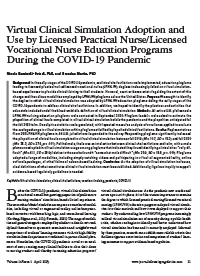
Virtual Clinical Simulation Adoption and Use by Licensed Practical Nurse/Licensed Vocational Nurse Education Programs During the COVID-19 Pandemic
In the early stages of the COVID-19 pandemic, as clinical site restrictions were implemented, education programs leading to licensed practical nurse/licensed vocational nurse (LPN/LVN) degrees increasingly relied on virtual simulation-based experiences to provide clinical training to their students. However, scant evidence exists regarding the extent of this change and the various modalities employed by LPN/LVN programs across the United States.
2023 | Research Item
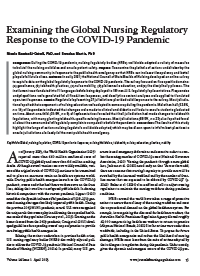
Examining the Global Nursing Regulatory Response to the COVID-19 Pandemic
During the COVID-19 pandemic, nursing regulatory bodies (NRBs) worldwide adopted a variety of measures to bolster the nursing workforce and ensure patient safety.
2023 | Research Item
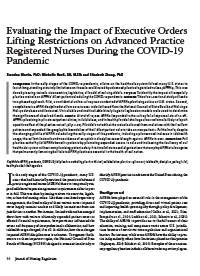
Evaluating the Impact of Executive Orders Lifting Restrictions on Advanced Practice Registered Nurses During the COVID-19 Pandemic
In the early stages of the COVID-19 pandemic, strains on the healthcare system forced many U.S. states to revisit long-standing statutory limitations on the care coordinated by advanced practice registered nurses (APRNs). This was done by issuing waivers via executive, legislative, or board of nursing orders.
2023 | Research Item
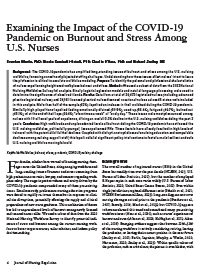
Examining the Impact of the COVID-19 Pandemic on Burnout and Stress Among U.S. Nurses
The COVID-19 pandemic has amplified long-standing issues of burnout and stress among the U.S. nursing workforce, renewing concerns of projected staffing shortages. Understanding how these issues affect nurses’ intent to leave the profession is critical to accurate workforce modeling.
2023 | Research Item
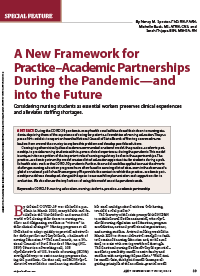
A New Framework for Practice–Academic Partnerships During the Pandemic—and into the Future
This chapter highlights the current status of transition-to-practice programs, both for RNs and APRNs.
2021 | Research Item
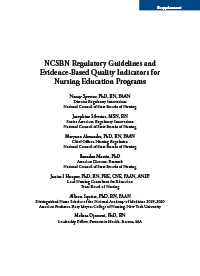
NCSBN Regulatory Guidelines and Evidence-Based Quality Indicators for Nursing Education Programs
From the Journal of Nursing Regulation July 2020 special supplement issue, NCSBN presents evidence-based regulatory guidelines and quality indicators for nursing programs.
2021 | Research Item

Board of Nursing Approval of Registered Nurse Education Programs
Read about the current status of the regulatory approval of nursing education programs in the United States. What are the challenges and opportunities for the future of program approval?
2018 | Research Item

Using Response Time to Detect Item Preknowledge in Computer-Based Licensure Examinations
This article addresses the issue of how to detect item preknowledge using item response time data in two computer-based large-scale licensure examinations. Item preknowledge is indicated by an unexpected short response time and a correct response. Two samples were used for detecting item preknowledge for each examination. The first sample was from the early stage of the operational test and was used for item calibration. The second sample was from the late stage of the operational test, which may feature item preknowledge. The purpose of this research was to explore whether there was evidence of item preknowledge and compromised items in the second sample using the parameters estimated from the first sample. The results showed that for one nonadaptive operational examination, two items (of 111) were potentially exposed, and two candidates (of 1,172) showed some indications of preknowledge on multiple items. For another licensure examination that featured computerized adaptive testing, there was no indication of item preknowledge or compromised items. Implications for detected aberrant examinees and compromised items are discussed in the article.
2016 | Research Item

Transition to Practice in Nonhospital Settings
A survey conducted in 2001, and replicated in 2003 with the same results, found that fewer than 50% of employers thought newly licensed nurses were safe and effective in practice. These findings caused concern for boards of nursing, so in 2002 the National Council of State Boards of Nursing (NCSBN) began to examine transition to practice (TTP) in nursing, developing an evidence-based model program and studying its effectiveness in hospital and nonhospital settings. After completion of the TTP study in hospitals with registered nurses (RNs) published earlier in 2015, a study was conducted in nonhospital facilities with RNs and licensed practical nurses to determine if NCSBN’s TTP program could be used effectively across settings. Sites volunteering to participate, however, faced many challenges while the study was underway. This article presents the TTP program, study design, challenges faced by nonhospital sites trying to implement a TTP program, and limited findings
2015 | Research Item

Perceptions of Nursing Practice: Capacity for High-Quality Nursing Home Care
Emerging evidence indicates that harmful nursing home resident outcomes occur because of ineffective collaboration between registered nurses (RNs) and licensed practical nurses (LPNs) during assessment, care planning, delegation, and supervision. This observational, factorial vignette survey related video vignettes of RN–LPN collaboration in nursing home care to RN perceptions of: 1) current practice in their home; and 2) preferred practice in their home (N = 444 rated vignettes of nursing practice).
2015 | Research Item

Differentiating Scopes of Practice in Nursing Homes: Collaborating for Care
Hospitalizations of nursing home residents are costly and adversely affect the health of already vulnerable residents, and reducing avoidable hospitalizations has been identified as a priority quality and safety outcome by the U.S. government. However, existing interventions to reduce hospitalizations do not account for differences in scopes of practice among licensed nursing staff. This article describes the development of an educational innovation for nursing home staff members to learn to collaborate in ways that differentiate registered nurse and licensed practical/vocational nurse scopes of practice and strengthen connections among licensed and unlicensed nurses to improve detection and management of conditions associated with avoidable hospitalizations. The innovation was developed using situated learning theory and facilitated unfolding case discussions, reflecting the actual care environment. Evaluation data indicated the feasibility of this approach to staff education.
2015 | Research Item

Faculty Development When Initiating Simulation Programs: Lessons Learned From the National Simulation Study
Nursing programs are seeking guidance from boards of nursing about how much simulation can be substituted for traditional clinical practice. To address this question and to assess educational outcomes when simulation is substituted for clinical time, the National Council of State Boards of Nursing (NCSBN) conducted a study using 10 nursing schools across the United States. This article focuses on the faculty development needed to maintain fidelity in the intervention, implementation, and evaluation processes of initiating simulation programs.
2015 | Research Item

NCSBN Simulation Guidelines for Prelicensure Nursing Programs
The National Council of State Boards of Nursing (NCSBN) published the results of the largest, most comprehensive study to date concerning the use of simulation as a substitute for traditional clinical experience. Results of the study, which were published in 2014, demonstrated that high-quality simulation experiences could be substituted for up to 50% of traditional clinical hours across the prelicensure nursing curriculum. An expert panel convened by NCSBN evaluated the data gathered through this study, examined previous research and the International Nursing Association for Clinical Simulation and Learning Standards of Best Practice: SimulationSM, and used their collective knowledge to develop national simulation guidelines for prelicensure nursing programs. This article presents those guidelines, evidence to support the use of simulation, and information for faculty and program directors on preparation and planning for using simulation successfully in their nursing programs.
2015 | Research Item

The National Council of State Boards of Nursing transition to practice study: Implications for educators
NCSBN's Transition to Practice (TTP) study: implications for educators.
2015 | Research Item

Simulation in Nursing Education: Current Regulations and Practices
Regulators have been discussing the issue of allowing simulation to replace clinical time for years and are looking for evidence to guide their decision making. In anticipation of the National Council of State Boards of Nursing National Simulation Study results, a descriptive survey was conducted to document the current regulatory environment on simulation and serve as a benchmark for future regulatory comparisons. This article reports the results of the survey.
2014 | Research Item

Measuring Post-Licensure Competence with Simulation: The Nursing Performance Profile
A valid, reliable practice assessment is needed to support intervention on the public's behalf when the pattern of a nurse's performance results in or is likely to result in patient harm. A collaborative multiagency research team developed and tested a criterion-referenced competency assessment process, using high-fidelity clinical simulation based on the Taxonomy of Error Root Cause Analysis and Practice Responsibility and the Clinical Competency Assessment of Newly Licensed Nurses. The 41-item instrument includes nine competency categories essential for safe practice. The instrument used with high-fidelity simulation testing shows promise as a reliable, valid method for identifying unsafe nursing practice.
2012 | Research Item

Results of the National Council of State Boards of Nursing (NCSBN) National Simulation Survey: Part II
The purpose of this article is to report additional data gathered during the NCSBN 2010 nationwide simulation survey of 1,729 nursing programs in the US. It serves as a companion article to the initial survey data reported by Hayden in 2010.
2012 | Research Item

Nurses' Competence Development During the First 5 Years of Practice
More than 2,000 practice anecdotes emailed by new nurses during their first 5 years of practice were analyzed to describe nurses’ definitions of competence and how it developed over time. Nurses defined competence as efficient care amid complex priorities; rapid response to subtle changes in patients’ conditions; seeing the big picture and working the system on patients’ behalf; interpersonal warmth, respect, and authority; and a committed desire to learn and improve. Support for development of these qualities may promote nursing care quality in high-acuity practice environments.
2010 | Research Item

Using Multiple-Patient Simulation Experiences to Foster Clinical Judgment
This multisite study examines the impact of multiple-patient simulation experiences on the development of students' abilities to make clinical judgments in evolving situations and the correlation between the design of the simulation and student outcome achievement in the final semester of their prelicensure nursing program.
2010 | Research Item

A Regulatory Model for Transitioning Newly Licensed Nurses to Practice
This article discusses the importance of developing a national, standardized program, implemented through regulation, for transitioning all newly licensed nursing graduates to practice.
2010 | Research Item

Use of Simulation in Nursing Education: National Survey Results
While simulation in nursing programs continues to increase, it is important to understand the prevalence of this new technology in nursing education, how this technology is utilized, and how educators are preparing to teach with this educational tool. This article reports on the results of a survey conducted by the National Council of State Boards of Nursing of 11,060 pre-licensure nursing programs in the United States as a means of describing use of simulation.
2010 | Research Item

Transition to Practice: Improving Patient Outcomes
This chapter examines the evidence that a standardized transition program for new graduate nurses has a positive impact on patient safety.
2009 | Research Item

Regulation Fosters Innovations in Nursing Education
Because of the complexities in nursing and healthcare delivery and a national focus on patient safety, there has been a call across nursing organizations and healthcare organizations for more innovation in nursing and healthcare education. The National Council of State Boards of Nursing held an invitational roundtable, involving representatives from nursing education organizations, boards of nursing, the American Nurses Association, and the Robert Wood Johnson Foundation. Topics of discussion included the meaning and implications of innovation in nursing education, perceived barriers to innovation, and the future of innovation. This article summarizes the outcomes of the roundtable’s discussion.
2009 | Research Item

Exit Exams: A regulatory perspective
A significant role for most state boards of nursing, whose mission is to protect the public, is the approval of nursing education programs in their state. As part of this process, many of the state boards review their schools’ annual pass rates of first-time NCLEX-RN candidates and compare these percentages to state regulations. Schools whose pass rates fall below the state standard risk losing the approval of their state board of nursing.
2006 | Research Item
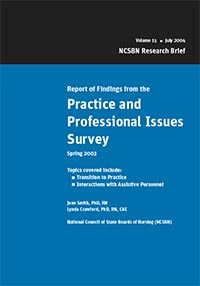
Report of Findings from the Practice and Professional Issues Survey (Vol. 15)
Practice and Professional Issues Surveys are conducted twice a year by NCSBN to collect information from entry-level nurses on specific practice activities and current professional issues.
2004 | Research Item
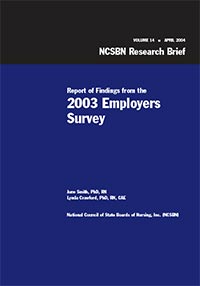
Report of Findings from the Practice and Professional Issues Survey (Vol. 12)
NCSBN has collected a wealth of information on a variety of regulatory topics. Prominent among those topics has been the preparation of new nurses for the practice setting and the issues surrounding the appropriate preparation and utilization of assistive personnel. Information has been gleaned on these topics from newly licensed nurses and assistive personnel. This study was designed to obtain the unique perspectives of health care employers on these issues.
2004 | Research Item

Ethics in practice: NCLEX results to disclose or not disclose
Individuals and organizations involved in nursing regulation, education, and practice can effectively increase their influence related to nursing regulation and improving health care in several ways.
2004 | Research Item
